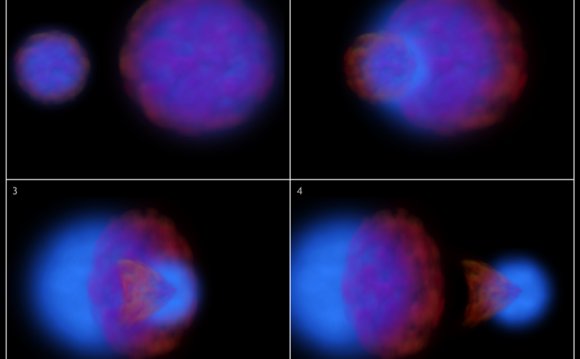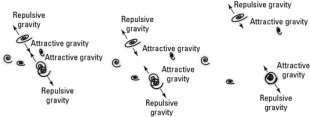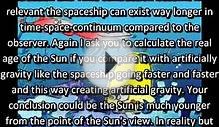
Two of the biggest mysteries of both string theory and cosmology are the presence of unseen dark matter and of repulsive gravity in the form of dark energy.
Dark matter: The source of extra gravity
Astronomers have discovered that the gravitational effects observed in our universe don’t match the amount of matter seen. To account for these differences, it appears that the universe contains a mysterious form of matter that we can’t observe, called dark matter Throughout the universe, there’s approximately six times as much dark matter as normal visible matter — and string theory may explain where it comes from!
In the 1930s, Swiss astronomer Fritz Zwicky first observed that some galaxies were spinning so fast that the stars in them should fly away from each other. Unfortunately, Zwicky had personality clashes with many in the astronomy community, so his views weren’t taken very seriously.
In 1962, astronomer Vera Rubin made the same discoveries and had nearly the same outcome. Though Rubin didn’t have the same issues of temperament that Zwicky did, many disregarded her work because she was a woman.
Rubin maintained her focus on the problem and, by 1978, had studied 11 spiral galaxies, all of which (including our own Milky Way) were spinning so fast that the laws of physics said they should fly apart. Together with work from others, this was enough to convince the astronomy community that something strange was happening.
Whatever is holding these galaxies together, observations now indicate that there has to be far more of it than there is the visible matter that makes up the baryonic matter that we’re used to — the matter that comprises you, your computer, this planet, and the stars.
Physicists have made several suggestions about what could make up this dark matter, but so far no one knows for sure.
Dark energy: Pushing the universe apart
Einstein’s cosmological constant allowed for a uniform repulsive energy throughout the universe. Since Hubble discovered the expansion of the universe, most scientists have believed that the cosmological constant was zero (or possibly slightly negative). Recent findings have indicated that the expansion rate of the universe is actually increasing, meaning that the cosmological constant has a positive value. This repulsive gravity — or dark energy — is actually pushing the universe apart. This is one major feature of the universe that string theory may be able to explain.
In 1998, two teams of astronomers announced the same results: Studies of distant supernovas (exploding stars) showed that stars looked dimmer than expected. The only way to account for this was if the stars were somehow farther away than expected, but the physicists had already accounted for the expansion of the universe. The explanation eventually found was startling: The rate of expansion of the universe was accelerating.
To explain this, physicists realized that there had to be some sort of repulsive gravity that worked on large scales (see the figure, below). On small scales, normal gravity rules, but on larger scales the repulsive gravity force of dark energy seemed to take over. (This doesn’t contradict the idea that the universe is flat — but it makes the fact that it is flat, while still expanding, a very unusual and unexpected set of circumstances, which required very narrow parameters on the early conditions of our universe.)

Repulsive gravity pushes galaxies apart, but attractive gravity tries to pull them together.
Repulsive gravity is theorized by inflation theory, but that’s a rapid hyper-expansion in the early phases of the universe. Today’s expansion due to dark energy may be remnants of the repulsive gravity from inflation, or it may be an entirely distinct phenomenon.
The finding of dark energy (or a positive cosmological constant, which it is roughly similar to) creates major theoretical hurdles, especially considering how weak dark energy is. For years, quantum field theory predicted a huge cosmological constant, but most physicists assumed that some property (such as supersymmetry, which does reduce the cosmological constant value) canceled it out to zero. Instead, the value is non-zero, but differs from theoretical predictions by nearly 120 decimal places!
In fact, results from the WMAP show that the vast majority of material in our present universe — about 73 percent — is made up of dark energy (remember from relativity that matter and energy are different forms of the same thing: = mc2, after all). The five-year WMAP data, released in 2008 and shown in the figure, below, also allows you to compare the composition of the present universe with the material present in the universe 13.7 billion years ago. The dark energy was a vanishingly small slice of the pie 13.7 billion years ago, but today it eclipses matter and drives the universe’s expansion.
Credit: Courtesy of NASA
The WMAP data allows you to compare today’s universe with the distant past.
The history of the universe is a fascinating topic for study, and trying to understand the meaning of this dark energy is one of the key aspects of modern cosmology. It’s also one of the key challenges to modern variations of string theory.
Today, many string theorists devote attention to these cosmological mysteries of the universe’s origins and evolution because they provide a universal playground on which the ideas of string theory can be explored, potentially at energy levels where string behavior may manifest itself.
INTERESTING VIDEO











